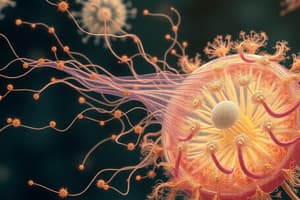Podcast
Questions and Answers
What are Paramecium?
What are Paramecium?
unicellular protozoans classified in the Kingdom Protista
Where do Paramecium live?
Where do Paramecium live?
quiet or stagnant ponds
How do Paramecium move?
How do Paramecium move?
cilia
What are cilia?
What are cilia?
Can the Paramecium change shape?
Can the Paramecium change shape?
What is the pellicle?
What is the pellicle?
What are the two types of nuclei in Paramecium?
What are the two types of nuclei in Paramecium?
What does the macronucleus control?
What does the macronucleus control?
What is the function of the micronucleus?
What is the function of the micronucleus?
What is reproduction in Paramecium?
What is reproduction in Paramecium?
What is conjugation?
What is conjugation?
What is the function of the contractile vacuole?
What is the function of the contractile vacuole?
Are Paramecium heterotrophic or autotrophic?
Are Paramecium heterotrophic or autotrophic?
Where does food enter the Paramecium?
Where does food enter the Paramecium?
How do Paramecium eat?
How do Paramecium eat?
What do Paramecium eat?
What do Paramecium eat?
What is the oral groove?
What is the oral groove?
What is the function of the trichocysts?
What is the function of the trichocysts?
What are avoidance behaviors in Paramecium?
What are avoidance behaviors in Paramecium?
How many kinds of cytoplasm are there in Paramecium?
How many kinds of cytoplasm are there in Paramecium?
What is ectoplasm?
What is ectoplasm?
What is endoplasm?
What is endoplasm?
Is the paramecium a multicellular organism?
Is the paramecium a multicellular organism?
To what kingdom do Paramecium belong?
To what kingdom do Paramecium belong?
Flashcards are hidden until you start studying
Study Notes
Paramecium Overview
- Paramecium are unicellular protozoans classified in the Kingdom Protista.
- They inhabit quiet or stagnant ponds and primarily feed on algae scum and other microorganisms.
Movement and Structure
- Locomotion is achieved through cilia, which are tiny hair-like projections covering their surface.
- Paramecium have a thick outer membrane called the pellicle, preventing shape changes unlike organisms such as amoebas.
Nuclei and Reproduction
- Contains two types of nuclei: macronucleus (large) and micronucleus (small).
- The macronucleus regulates cellular activities like respiration, protein synthesis, and digestion.
- The micronucleus is involved in reproduction, exchanging DNA during a process called conjugation.
Feeding Mechanism
- Paramecium are heterotrophic, obtaining nutrients by consuming organic material.
- Food enters through the mouth pore, is directed to the gullet, with cilia sweeping food into the oral groove to form food vacuoles.
Sensory and Defense Mechanisms
- Paramecium can sense temperature, food availability, oxygen levels, and toxins.
- Defensively, they utilize trichocysts—tiny threads ejected to entangle predators or make the organism appear larger.
Cytoplasm Types
- Has two distinct types of cytoplasm: ectoplasm (outer layer) and endoplasm (dense interior).
Behavioral Traits
- Exhibit avoidance behaviors, moving away from negative or unpleasant stimuli.
Additional Functional Features
- The contractile vacuole helps maintain water balance by expelling excess water.
- The oral groove, appearing pinched, facilitates food intake.
Studying That Suits You
Use AI to generate personalized quizzes and flashcards to suit your learning preferences.




